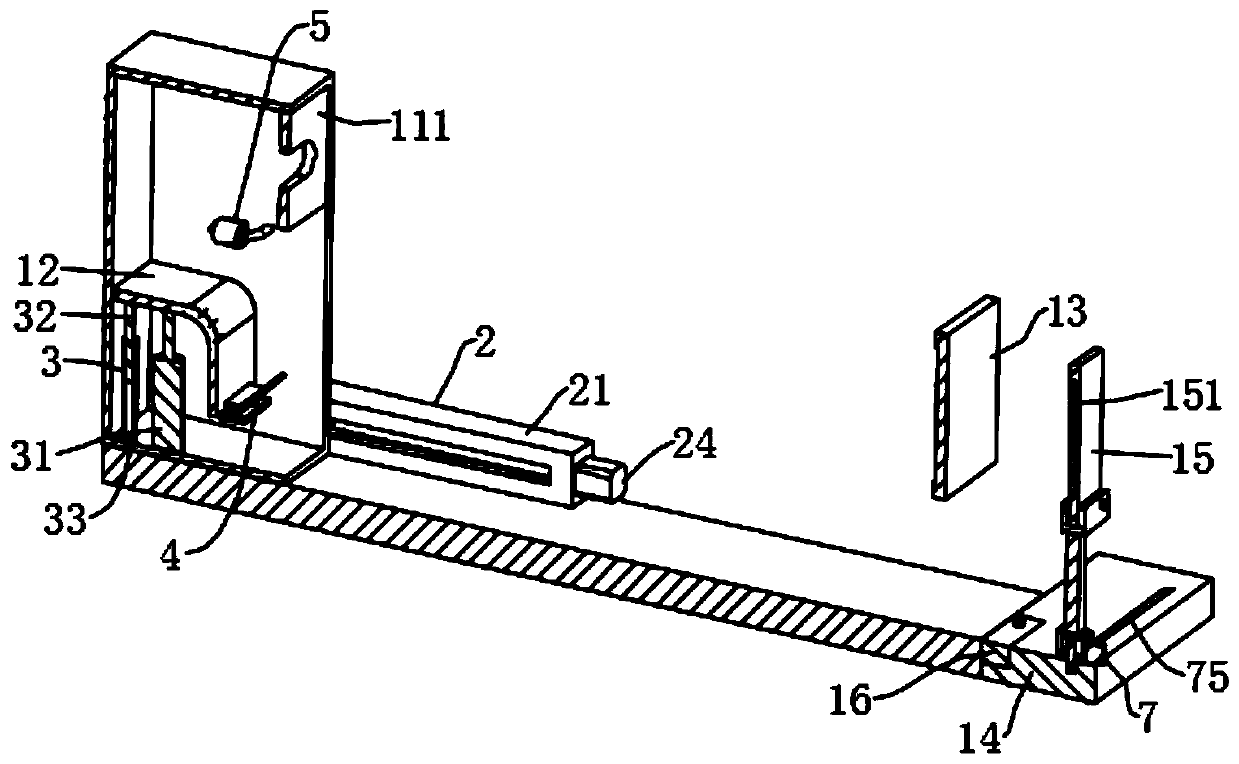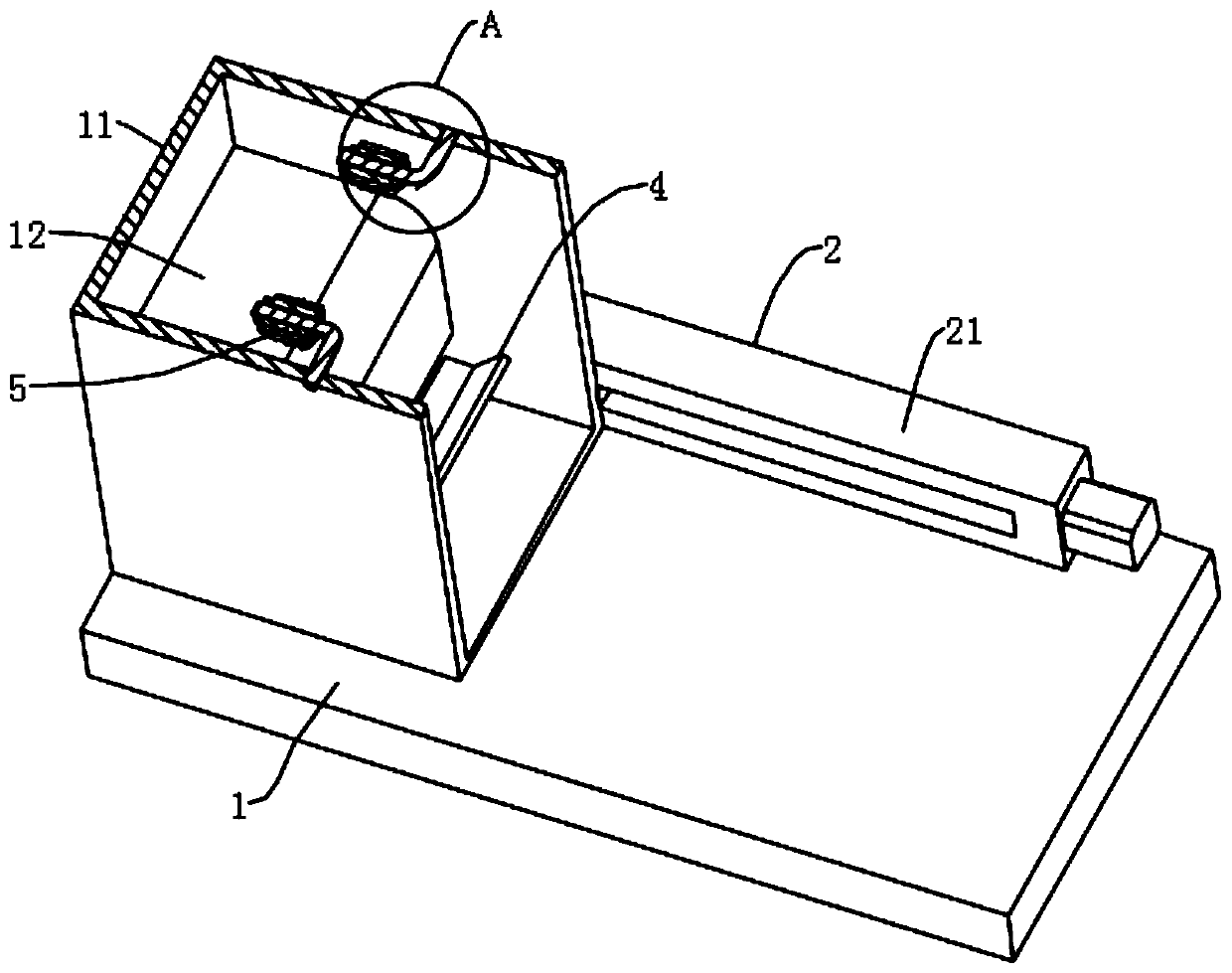Psychology teaching auxiliary device
A teaching aid and psychological technology, applied in the field of psychology, can solve problems such as inconvenient adjustment of experimenters, inability to shield the environment, difficulty in convenient experiments, etc.
- Summary
- Abstract
- Description
- Claims
- Application Information
AI Technical Summary
Problems solved by technology
Method used
Image
Examples
Embodiment 1
[0055] refer to figure 1 and figure 2 , a psychology teaching aid, mainly includes the following parts:
[0056] A support platform 1, the support platform 1 is used to support the whole device;
[0057] Slidingly connected to the isolation bin 11 above the support platform 1;
[0058] A first driving assembly 2 for driving the horizontal sliding of the isolation bin 11;
[0059] The seat plate 12 installed in the isolation bin 11 is vertically adjustable;
[0060] A second drive assembly 3 for driving the seat plate 12 to slide vertically;
[0061] The feet placing assembly 4 for placing both feet connected on the seat board 12;
[0062] Disassemble the relaxation auxiliary assembly 5 connected to the isolation chamber 11 both sides for psychological relaxation;
[0063] A display 13 for displaying pictures;
[0064] A third driving assembly 6 for controlling the rotation of the display 13;
[0065] The base 14 installed on the end side of the support platform 1;
...
Embodiment 2
[0081] The difference with Embodiment 1 is: the surface of the seat plate 12 is also coated with a layer of antifouling coating, because the seat plate 12 is for the experimenter of the psychological test to sit and stand, it becomes dirty easily, in order to facilitate the seat plate The surface of 12 is cleaned, so the surface of the seat plate 12 is sprayed with an antifouling coating, wherein the antifouling coating is prepared by the following method:
[0082] Take the following components by weight for subsequent use: 50 parts of epoxy resin, 50 parts of acrylic resin, 50 parts of polycarbonate, 20 parts of iron oxide red powder, 20 parts of titanium dioxide powder, 40 parts of ethyl acetate, 30 parts of cyclohexanone 20 parts, 20 parts of alkanolamide and 10 parts of diphenyl ethyl ketone;
[0083] S1. Prepare anti-fouling coating pre-preparation solution; mix and stir epoxy resin, acrylic resin and polycarbonate evenly, add to the reaction kettle and heat to 200°C, and...
Embodiment 3
[0088] The difference from Example 2 lies in the preparation of the antifouling coating on the surface of the seat plate 12, wherein the antifouling coating is prepared by the following method:
[0089] Take the following components by weight for subsequent use: 55 parts of epoxy resin, 55 parts of acrylic resin, 55 parts of polycarbonate, 20 parts of iron oxide red powder, 20 parts of titanium dioxide powder, 40 parts of ethyl acetate, 30 parts of cyclohexanone 20 parts, 20 parts of alkanolamide and 10 parts of diphenyl ethyl ketone;
[0090] S1. Prepare anti-fouling coating pre-preparation solution; mix and stir epoxy resin, acrylic resin and polycarbonate evenly, add to the reaction kettle and heat to 203°C, and then keep it warm for 24min;
[0091] S2. Preparation of antifouling coating solution: After cooling the antifouling coating pre-preparation solution obtained in S1 to 153°C, add iron oxide red powder, titanium dioxide powder, ethyl acetate, cyclohexanone, alkanolam...
PUM
 Login to View More
Login to View More Abstract
Description
Claims
Application Information
 Login to View More
Login to View More - R&D
- Intellectual Property
- Life Sciences
- Materials
- Tech Scout
- Unparalleled Data Quality
- Higher Quality Content
- 60% Fewer Hallucinations
Browse by: Latest US Patents, China's latest patents, Technical Efficacy Thesaurus, Application Domain, Technology Topic, Popular Technical Reports.
© 2025 PatSnap. All rights reserved.Legal|Privacy policy|Modern Slavery Act Transparency Statement|Sitemap|About US| Contact US: help@patsnap.com



